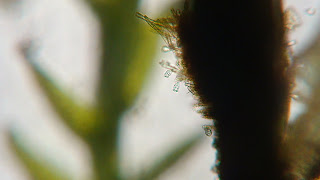INFORMATIONS
This week we are going to observe and find a general existing microanimal and microorganisms in the glass tank. We want know the numbers of the population in the glass tank, their growth process and densities. We are going to gather all observations before to write a final laboratory report on MicroAquarium.
OBSERVATION 4
My observations of this week on November 5th are that a few fresh-water communities are still growing and the population of rotifers, diatoms, desmids, nematodes and euglena are increasing. Though the population of diatom is dying and they are everywhere. See MP4: Annelida below. You will see the millions of thread-like algae and some dead microorganisms sprinkled around Plant A. The algae are growing plenty of “hair-like.” The Plant A & B are turning green to brown.
This microanimal is new to me. I saw several of annelida swarming around on Plant A & B. I took a MP4 video of it to see how it is moved by its several flagella. It is beneath the medium & high power of microscope. It is compressed in 10.3 megabytes and it is under lightfield illumination at a magnification of medium & high power with a playing time of 44 seconds. It is to be mobile and it moves slowly around like worm-like but in one place. It is completely covered by See that tail at the end of the video clip is a mouth. It is called Stylaria lacustris (Pennak 303), identified with help by Dr. McFarland and species found in the book, Fresh-Water Invertebrates of the United States by Robert W. Pennak.

Fig. 1: Zygnema
Others I don’t recognized its species, but it is fascinated to see that seems to be act like a gel on Plant A. See figure 2 below. I think it is Eudorina elegans (Egmond, 1994) because of its similar composition of cells and it looks like Volvox.
Fig. 2
It remains stationary and it seems it grows outward from the center. It is because of crowding among the filaments that forces the cells into abnormal circular shape. With help from Dr. McFarland and The book of Handbook of Algae shows it is Coleochaete irrregularis. (Forest 89). See Figure 3 below.

Fig. 3
The couple of bell stalk-like Vorticella stands out boldly on dying Plant A. (Patterson 113). See figure 4.
Fig. 4: Vorticella
The strange microanimal we could not identify in first week of observation reveals that it was just a young stage of Cyclop. You can see the flagella on its tail. It is starting to grow.

OVERALL
Diatoms are dying due to its life period and it appears to be little crowding in the glass tanks. I supposed that is why they could not move around much to get nutrients. Since the results of 4 weeks of observation, more rotifers are continuing to grow. Counting the microorganisms, Cyclops and rotifers exceed more than other organisms in fresh-water pond from runoff from cemetery. The least microorganism is seed shrimp. I don’t see any more much of that.
REFERENCES
Egmond, Wim van. (1994). The Algae Archive of the Micropolitan Museum. Data Retrieved on 6 Nov. 2009.
Forest, Herman Silva. (1959). Handbook of Algae. The University of Tennessee Press. 89
Patterson, D.J. (2003). Free-Living Freshwater Protozoa. Manson Publishing: Washington D.C. 113.
Pennak, Robert W. (1989). Fresh-Water Invertebrates of the United States. John Wiley & Sons, Inc: New York. 303
Prescott, G.W. (1964). The Fresh-Water Algae. W.M.C. Brown Company Publishers. 101



No comments:
Post a Comment